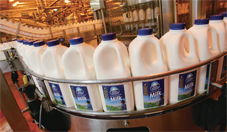Novel technologies can lead to new beverages, and vice versa, which influence consumer behavior
 WHY does beer smell of bananas, cloves or licorice? Does ESL milk really taste as good as fresh milk? What messages do colors portray on labels and packaging? Sweet and healthy ?is it possible? Without technology there would be no products. But new products, in turn, can sometimes foster the development of new technologies. What follows is a brief (and by no means comprehensive) look at some of the very latest themes from the world of beverages and food that were presented at drinktec 2009. It's not all about the technology used to manufacture and bottle beverages and liquid food ?it is also of course about the products themselves?topics that are being hotly debated in the sector at the moment and which in some cases are already affecting consumer behavior.
WHY does beer smell of bananas, cloves or licorice? Does ESL milk really taste as good as fresh milk? What messages do colors portray on labels and packaging? Sweet and healthy ?is it possible? Without technology there would be no products. But new products, in turn, can sometimes foster the development of new technologies. What follows is a brief (and by no means comprehensive) look at some of the very latest themes from the world of beverages and food that were presented at drinktec 2009. It's not all about the technology used to manufacture and bottle beverages and liquid food ?it is also of course about the products themselves?topics that are being hotly debated in the sector at the moment and which in some cases are already affecting consumer behavior. When beer smells like licorice
Does your beer smell of bananas, cloves or licorice? Yes? Don抰 worry ?you can trust your nose, because everyone can smell and taste these nuances in the finished product. Beer is one of the most multifaceted beverages in the world, with around 8,000 ingredients to discover. By way of comparison, red wine has 搊nly?1,200. This sensory journey starts with the essence of any of these beers ?malt. The rule here is that the more malt that is dissolved in the brewing liquor, the higher the wort content, which gives a fuller flavor. Malt also brings color and very special aromas into play, ranging from a sweet caramel note, reminiscent of block malt, to roasted aromas such as licorice, chocolate and coffee. Hops also offer real variety, because the 揼reen gold?has long been used to create more than just bitter flavors. There is a great difference between what are known as bitter hops and aroma hops. In the case of bitter varieties the hop flower in the beer tends to be subtle, although the 損erceived? bitter flavor is much stronger than with an aroma hop. By contrast, beer made using aroma hops smells fresh and spicy, sometimes even with citrus aromas, and the bitter flavor is pleasantly mellow. The final component providing the aroma is yeast, both bottom- fermented and top-fermenting strains. Wheat beers, which smell either of cloves or ripe bananas, are typical results of top-fermenting yeasts. Bottom-fermented yeasts tend to provide less strong aromas, which are the optimal platform for hoppy beers, for example. But once again the exception proves the rule. After long storage bottom-fermented strong beers acquire fruit notes such as apple or blackberry.
The final component providing the aroma is yeast, both bottom- fermented and top-fermenting strains. Wheat beers, which smell either of cloves or ripe bananas, are typical results of top-fermenting yeasts. Bottom-fermented yeasts tend to provide less strong aromas, which are the optimal platform for hoppy beers, for example. But once again the exception proves the rule. After long storage bottom-fermented strong beers acquire fruit notes such as apple or blackberry. Innovation or not?
ESL milk has already pushed fresh milk off many refrigerator shelves. Some people say that this is a clear signal that consumers are accepting the milk. Others disagree, saying that the retail trade and industry are just using ESL to optimize their margins. But what's the real story? ESL stands for 揈xtended Shelf Live? and the shelf life of ESL milk in the refrigerator is around three weeks, compared to conventionally pasteurized fresh milk that usually goes off after a week. Bacterial spores are responsible for this, as they are not destroyed in traditional pasteurization conditions and tend to germinate sooner rather than later. ESL reduces these bacterial spores and so extends the shelf life in very different ways. The most common process is VTIS, in which the milk is heated to 127癈 in fractions of seconds using steam injection and stays at this temperature for around two seconds. In comparison, milk is pasteurized to 72?to 75癈 for 30 seconds while long-life milk is heated to 150癈 for three seconds. The two other processes focus on mechanically separating the bacteria and spores using membrane filtraJunior
 iConnectHub
iConnectHub
 Login/Register
Login/Register Supplier Login
Supplier Login


























